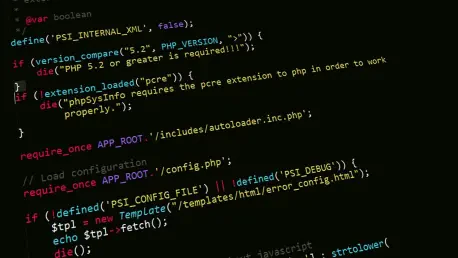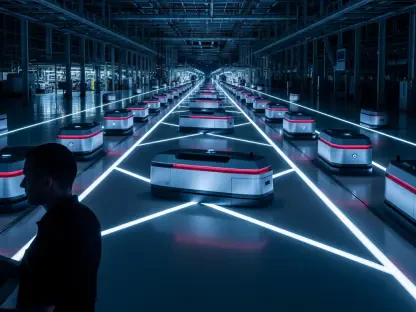The rapid evolution of artificial intelligence continues to reshape industries, and nowhere is this more evident than in the realm of coding and software development, where precision and efficiency are paramount. Anthropic, a frontrunner in AI research, has recently launched its groundbreaking Claude 4 models—Claude Opus 4 and Claude Sonnet 4—ushering in a new era of technological capability. These models are not just incremental updates but represent a significant leap forward, promising to transform how developers approach complex tasks. With a focus on superior coding performance, enhanced reasoning, and innovative tools, they aim to set unprecedented benchmarks in the field. This development signals a shift toward more reliable and productive AI solutions, catering to the needs of developers and businesses alike. As the industry grapples with increasingly intricate challenges, the arrival of these models offers a compelling glimpse into the future of AI-driven programming.
Unparalleled Coding Performance
The standout feature of Claude Opus 4 lies in its remarkable ability to handle sophisticated coding tasks with unmatched precision, positioning it as a leading model in the global AI landscape. Designed for sustained performance, it excels in long-running projects that demand deep engagement with complex codebases. Industry benchmarks such as SWE-bench and Terminal-bench have recorded top-tier results for this model, highlighting its capacity to improve code quality significantly. Endorsements from prominent platforms underscore its effectiveness in navigating intricate programming environments, making it an invaluable asset for developers tackling large-scale projects. Beyond raw power, the model’s ability to maintain consistency over extended periods sets it apart from predecessors, addressing a critical need for reliability in professional settings. This focus on enduring performance ensures that even the most demanding tasks are completed with a high degree of accuracy, reducing errors and streamlining workflows for teams across various sectors.
Meanwhile, Claude Sonnet 4 complements its counterpart by refining the art of instruction-following and problem-solving, delivering results that meet the nuanced demands of modern coding challenges. Its enhanced precision allows it to interpret complex directives with clarity, ensuring that outputs align closely with user intent. This model powers advanced tools in prominent development ecosystems, earning praise for its seamless integration and effectiveness in navigating codebases of varying complexity. Companies in the tech space have noted its ability to tackle intricate problems with a level of sophistication that elevates productivity. Unlike earlier iterations, this version emphasizes detailed reasoning, which translates into fewer misunderstandings during task execution. For developers, this means less time spent on revisions and more focus on innovation, as the model adeptly handles the intricacies of programming logic. Its contributions signal a broader trend toward AI that not only performs tasks but anticipates needs, reshaping expectations for automated coding assistance.
Innovative Features for Developers
Alongside raw performance, the Claude 4 models introduce a suite of innovative features designed to empower developers with tools that enhance both functionality and accessibility. Extended thinking capabilities, currently in beta, allow these models to alternate between reasoning and tool application, creating a more dynamic approach to problem-solving. Features like parallel tool usage and improved memory functions further boost their effectiveness, enabling seamless handling of multifaceted tasks. The general availability of Claude Code within popular environments such as VS Code and JetBrains ensures that a wide range of developers can integrate these advancements into their daily workflows. Additionally, API enhancements like prompt caching and code execution tools provide the flexibility needed to build robust AI agents, catering to diverse project requirements. These advancements reflect a thoughtful design philosophy aimed at bridging the gap between cutting-edge technology and practical application, making sophisticated AI accessible to a broader audience.
Another critical aspect of these models is their focus on enhancing user experience through thoughtful integrations and platform compatibility, ensuring that developers can leverage their capabilities without steep learning curves. Accessibility through major platforms like Amazon Bedrock and Google Cloud’s Vertex AI means that businesses of all sizes can adopt these tools with ease, maintaining continuity with existing systems. Pricing structures aligned with previous models also demonstrate a commitment to affordability, removing financial barriers to entry for many organizations. The inclusion of memory retention features for long-term task awareness further aids developers in managing extended projects without losing context, a common challenge in AI-assisted coding. By prioritizing usability alongside innovation, Anthropic ensures that the Claude 4 models are not just powerful but also practical, addressing real-world needs in software development while fostering an environment where creativity and efficiency can thrive together.
Commitment to Safety and Reliability
Safety and reliability form a cornerstone of Anthropic’s approach with the Claude 4 models, reflecting a broader industry push toward responsible AI development. Measures to curb shortcut behaviors in task completion have been implemented, ensuring that outputs remain thorough and dependable even under pressure. Improved memory retention for sustained task awareness means that these models can handle prolonged engagements without losing critical context, a vital feature for complex coding endeavors. Thinking summaries, which condense lengthy reasoning processes, also enhance transparency, allowing users to understand the logic behind outputs more clearly. Rigorous testing under elevated AI Safety Levels underscores a dedication to mitigating risks, aligning with ethical standards that prioritize user trust. This meticulous attention to coherence and accountability sets a precedent for how AI can balance innovation with responsibility, addressing concerns that often accompany rapid technological advancements.
Equally important is the impact of this safety-focused design on fostering confidence among developers and businesses adopting these tools for mission-critical applications. By minimizing errors through enhanced reliability features, the models reduce the likelihood of costly mistakes in high-stakes environments. The emphasis on ethical AI development also resonates with a growing demand for transparency in how algorithms operate, especially in sectors where precision is non-negotiable. Partnerships with industry leaders to validate these safety protocols further reinforce their credibility, ensuring that the technology meets stringent standards before widespread deployment. This holistic approach not only protects end-users but also positions Anthropic as a leader in advocating for AI that serves humanity responsibly. As a result, the Claude 4 models stand as a testament to the possibility of marrying cutting-edge performance with a framework that prioritizes integrity, setting a new bar for what AI can achieve in professional settings.
Shaping the Future of AI-Driven Coding
Reflecting on the launch of Claude Opus 4 and Claude Sonnet 4, it becomes clear that Anthropic has achieved a milestone in redefining what AI can accomplish in coding and beyond. Their exceptional performance in benchmarks and real-world applications marks a turning point, demonstrating that AI can tackle even the most intricate programming challenges with finesse. The integration of innovative tools and safety measures further solidifies their standing as trusted solutions in a competitive landscape. Industry endorsements highlight a shared belief in their transformative potential, affirming that these models have set a new standard for productivity and reliability.
Looking ahead, the next steps involve exploring how developers and businesses can fully harness these advancements to drive innovation in their respective fields. Experimenting with the models’ capabilities in diverse scenarios will uncover additional use cases, from automating routine tasks to solving unprecedented challenges. Staying updated on evolving API features and safety protocols will also ensure that users maximize benefits while adhering to ethical guidelines. Ultimately, the legacy of Claude 4 models lies in their ability to inspire a future where AI and human ingenuity collaborate seamlessly, pushing the boundaries of what technology can achieve.









